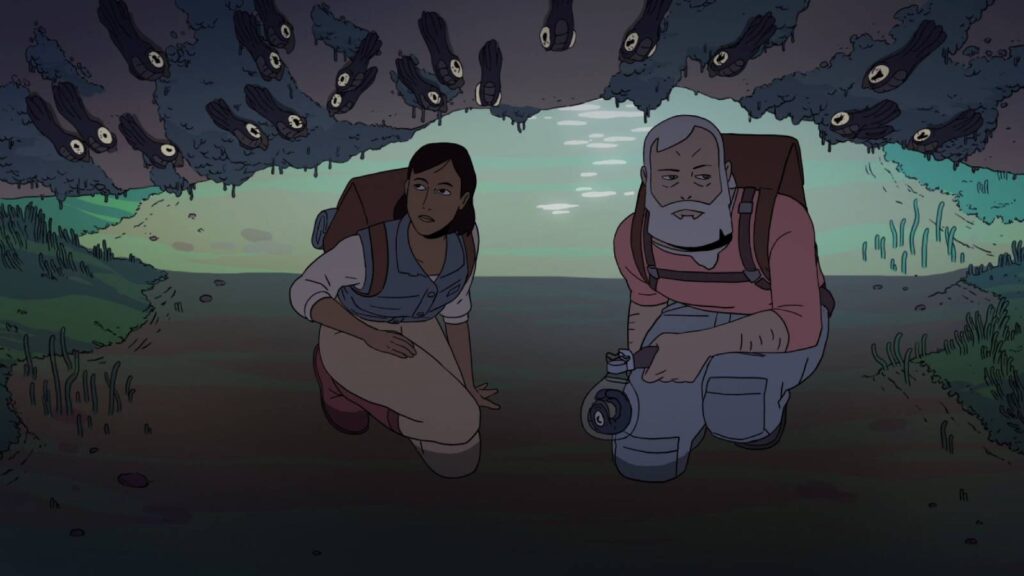The recent HBO Max thriller series Scavengers Reign follows the residents of an isolated community as they grapple with a sinister experiment orchestrated by the enigmatic Ms. Keller. As the show hurtles towards its ominous ending, fans are left with as many questions as the bewildered townspeople.
What is the experiment’s purpose? Who is behind it? And what ultimately happens to the doomed inhabitants? This comprehensive article will analyze the cryptic clues to decoding Scavengers Reign’s eerie conclusion.
Table of Contents
Background: The Nature of the Experiment
Scavengers Reign is set in the dusty town of God’s Vale, seemingly filled with eccentric locals leading humble lives. However, ominous clues hint that there is more happening underneath the surface. The quirky Ms. Keller introduces various behavioral experiments on the townspeople, from secret care packages to stranger danger awareness in children.
As her unorthodox techniques spark confusion and unrest, it becomes evident her experiments serve a shadowy ulterior motive.

Analyzing Key Details Behind the Ending
The True Purpose of Ms. Keller’s Scheme
While the residents initially perceive Ms. Keller as an oddball do-gooder, the ending reveals her sociological experiments are part of a covert government-sanctioned operation. She admits to studying behavioral science and isolating ideal conditions to test human nature under duress.
God’s Vale proved the perfect encapsulated environment to conduct her sinister social engineering undisturbed.
The Masterminds Behind the Experiments
While Ms. Keller carried out the experiments, the finale exposes she is merely a cog following orders from more powerful players. These shadowy officials remain nameless but certainly occupy elite posts if they can authorize such dangerous studies on unsuspecting civilians. Their interest likely stems from weaponizing behavioral science for governmental agendas.
The Intended Aftermath
As paranoia heightens after Ms. Keller reveals the experiments’ parameters were intentionally designed to fracture community ties and pit residents against one another. This breakdown of solidarity and humanity serves as a case study on how ordinary people revert to their baser survival instincts when social structures collapse.
The orchestrators seem to be testing psychological endurance in conditions mirroring lawlessness, anarchy, or even war.

Perspectives on the Ominous Implications
Cultural anthropologist Timothy Miller speculates,
“the experiments depict the human psyche reverting to a primal ‘survival of the fittest’ mode given particular environmental stimuli. Much like notorious historical studies like the Stanford Prison Experiment, the mysterious overseers are coldly studying the bounds of human anguish much like lab rats.”
Horror novelist Mary Shelley critiques,
“The ending presents a sobering commentary on human nature’s fragility when orderly systems controlling baser urges disintegrate. The descent into paranoia and betrayal evokes the ominous questions of who watches the watchmen or controls the controllers?”
Deciphering Key Questions
Why did Ms. Keller choose God’s Vale?
As a remote, isolated settlement with little contact to external society, God’s Vale provided the perfect controlled environment to conduct experiments on behavioral psychology. Its self-sufficient natureand eccentric locals prone to suspicion ensured reactions would remain unchecked and undiscouraged by outsiders. The remoteness also guaranteed secrecy free of disruptive scrutiny.

Did the residents have any agency against the unseen forces manipulating them?
While the cryptic experiments sparked confusion and unrest in the town, the residents arguably maintained elements of free will rather than behaving as complete puppets. Their ultimate reactions centered more on personal fears, insecurities and moral fiber than external cues. However, their isolation and tight communal ties accelerated tensions once unity evaporated into suspicion and self-interest.
What is the broader implication behind such dangerous experiments against civilians?
Secretive governmental interests investing in weaponizing behavioral science for social engineering present chilling implications on personal liberties and ethical boundaries. The ending essentially serves as a cautionary tale around what human beings are capable is ordinary safeguards controlling civilization and morality are stripped away and replaced with external pressures designed to fracture human cooperation while encouraging baser motivations.
The descent into instability and paranoia in God’s Vale serves as a microcosm demonstrating the line between order and anarchy rests on delicate psychological balances within both individuals and groups.

Key Takeaways
- Scavengers Reign traced a sinister social experiment within an isolated town devolving into instability and paranoia as communal ties unraveled.
- Orchestrator Ms. Keller admitted she deliberately introduced external catalysts designed to accelerate suspicion and self-interest.
- The experiments actually served shadowy governmental interests seeking to develop behavioral science for weaponization and social engineering.
- The ending demonstrates how tenuous social stability and human cooperation remain when external forces strategically dismantle the psychological safeguards maintaining order.
Scavengers Reign’s disturbing conclusion essentially serves as a cautionary allegory for civilization’s fragility against sinister forces and moral ambiguity hidden beneath the surface. While God’s Vale recovered order by removing Ms. Keller’s disruptive presence, her overseers remain unidentified and undisrupted, free to advance their agenda through future experiments elsewhere.
The ominous ending leaves audiences questioning who the true “scavengers” or “predators” in society might be.

